
Following on from my recent articles on land-use regulations and housing affordability, I want to take readers through Texas’ deregulated and innovative urban planning system, and how this system has assisted in providing Texans with housing that is among the most affordable in the Western world despite very high population growth and easy access to credit.
There are many lessons that can be applied to Australia, particularly with respect to: (1) ensuring an adequate supply of affordable land for housing; (2) speeding-up development approval processes; and (3) ensuring housing-related infrastructure is adequately financed in order to facilitate the provision of affordable housing.
Before I commence, consider the following facts about Texan housing compared with US housing markets where land/housing supply was/is constrained by regulatory and/or physical barriers.
First, Texan housing has remained relatively affordable when measured against median household incomes:
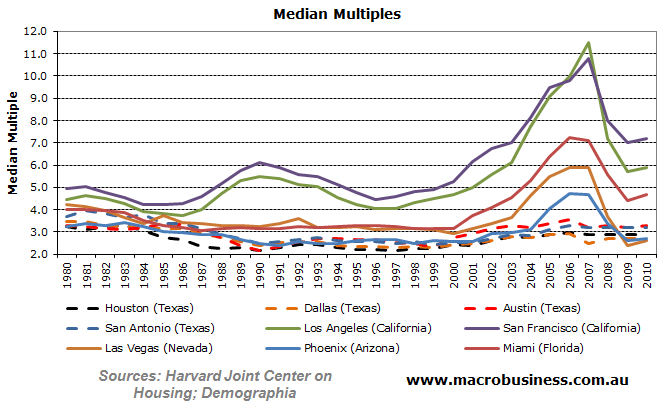
Second, Texan house prices have experienced far lower levels of volatility than the supply-restricted states:
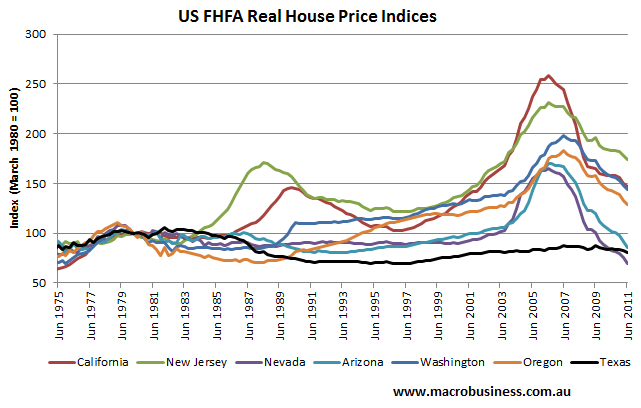
Third, because house prices have remained affordable, and low-cost housing has always been available to would-be buyers, Texan households never had to take on huge sums of debt in order to purchase a home, unlike their counterparts in the supply restricted states:
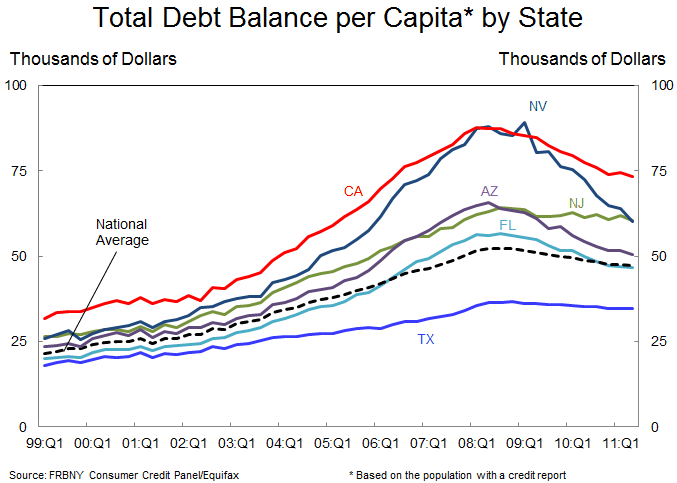
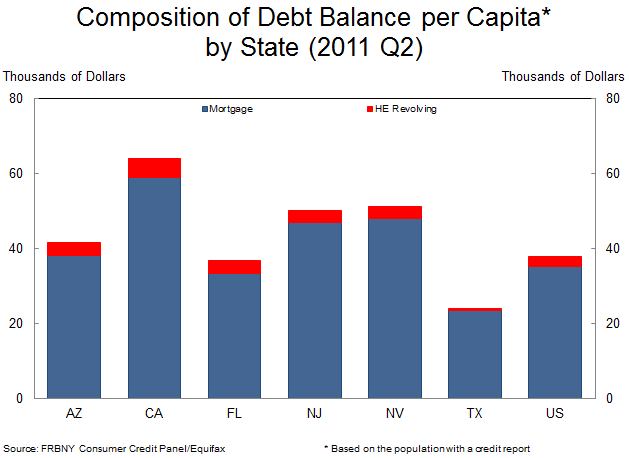
Finally, because of the low-cost housing in Texas, in addition to the lower rents on offer to businesses (because of lower urban land prices), the cost of living in Texas (as well as Georgia, which operates similar land-use policies) is far lower than the rest of the country. For example, Houston’s overall after-tax living costs are 9% below the nationwide average and 19% below the average for large metro areas (see below table).
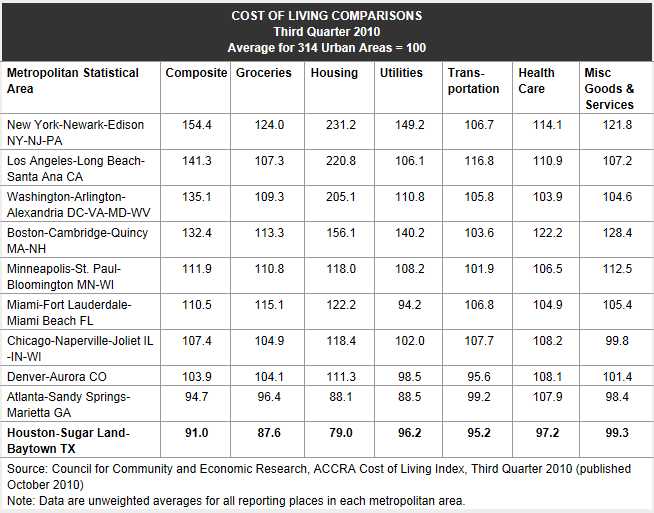
What makes Texas’ housing situation unique is the way in which it:
- Enables a plentiful supply of affordable land for housing and operates speedy housing approval processes; and
- Ensures housing-related infrastucture is adequately financed and provided in order to support the provision of affordable housing.
The following extracts from two seperate papers summarise the Texan housing model well. The first paper, which comes from the Cato Institute’s Randall O’Toole, describes how land-supply is provided and infrastructure financed in Houston, Texas:
Houston is an example of a place where, with minimal government regulation, the supply curve for housing is almost perfectly elastic. Houston and surrounding areas have no zoning, so developers face minimal regulation when building on vacant land. Once built, most developers add deed restrictions to their properties in order to enhance their value for buyers who want assurance that the neighborhood will maintain a positive character. But these deed restrictions do not impede further growth, as there is plenty of land in the region without such restrictions.
In the suburbs of Houston, developers often assemble parcels of 5,000 to 10,000 acres, subdivide them into lots for houses, apartments, shops, offices, schools, parks, and other uses, and then sell the lots to builders. The developers provide the roads, water, sewer, and other infrastructure using municipal utility districts, which allow homebuyers to repay their share of the costs over 30 years. At any given moment, hundreds of thousands of home sites might be available, allowing builders to quickly respond to changing demand by building both on speculation and for custom buyers…
Houston developers allow homebuyers to pay off infrastructure costs over 30 years, impact fees or development charges require up-front payments often totaling tens of thousands of dollars. The difference is crucial for housing affordability: since development charges increase the cost of new housing, sellers of existing homes can get a windfall by raising the price of their houses by an amount equal to those charges, thus reducing the general level of housing affordability.
Increasing land and housing costs make other things more expensive as well. When housing is more expensive, for example, businesses must pay their employees more so that workers can afford to live in the region…
If lower interest rates increase demand for housing, Houston-area homebuilders respond by building more homes; [by contrast, in supply-restricted cities like the] San Francisco-area, builders respond by filing more applications, which may wait several years for approval. If government purchase of a large block of land for a park or open space restricts supply, Houston-area builders can simply go somewhere else nearby; in the San Francisco area, the nearest alternative building location is more than 50 miles away.
Notice that inelastic supply not only makes housing prices rapidly increase with small increases in demand; it also makes housing prices rapidly fall with small decreases in demand. This is exacerbated by lengthy permitting periods that can put homebuilders out of phase with the market. Thus, land-use restrictions create conditions ripe for housing bubbles.
As mentioned in the above extract, a key feature of the Texan housing system is the Municipal Utility District (MUD) financing system for housing-related infrastructure and services. Here’s a break-down of how the MUD system works:
- Utilities are installed and maintained by the companies (electricity, telephone etc) since they receive the revenue.
- The developer has to install the roads.
- Large subdivisions are allocated areas for parks and schools.
- The developer installs the sewerage and water and gets it back from the Municipal Utility District.
- MUD is a special-purpose district that provides public utilities (such as electricity, natural gas, sewage treatment, water, and waste collection/management) to the residents of that district.
- MUDs are formed by a vote of the area, and represented by board of directors who are voted on by the local people.
- The MUD borrows money via the bond market to pay for building (via the developer) and operating (via the MUD) these services. The MUD bonds are then repaid via taxes on the home owners of around 1% of the home values per year.
- Schools are also built and funded via bonds and repaid via the same taxes on the homeowner.
Note that Texas does not levy infrastructure charges up-front which, when combined with the absence of artificial regulatory constraints on land supply, enables generous-sized serviced housing blocks to be provided for only $US30,000 to $40,000, with brand-new family-sized house and land packages available for only $US150,000.
The second article, which comes from the Dallas Federal Reserve, also provides a great summary of the Texas housing system:
In the first phase of the U.S. housing market boom and bust, many large cities (primarily on the East and West coasts) saw a prolonged run-up in prices. Demand for housing, driven by low interest rates and a growing economy, combined with supply restrictions—such as zoning laws, high permitting costs and “not in my backyard” regulations—to contribute to rapid price appreciation…These price increases then fed off themselves. Rising prices—whether for gold, corn or houses—often foster a bubble mentality, contributing to speculative demand…
Atlanta [Georgia], Dallas and Houston [Texas]…weathered increased demand largely with new construction rather than price appreciation because of the ease of building new homes. While some are dismissive of this developer-friendly attitude that allows such rapid construction, the approach clearly carries significant benefits for the homebuyer…
The Houston Example:
Houston saw tremendous job and population growth over the last decade, ranking it high among the 12 largest U.S. metropolitan areas in both metrics…
Given that Houstonians had access to the same new types of mortgages as the rest of the country and that Houston has had greater population growth than other large metros, we might expect price appreciation to be stronger in Houston than elsewhere. However, the opposite has been true.
Houston’s large supply of land means that demand growth primarily results in more construction, not higher prices. Construction levels are limited by the availability of two kinds of developable land: the previously undeveloped, generally found on a metro’s outskirts, and the redeveloping, usually in a city’s interior. In both cases, Houston’s policies are relatively permissive, making the metro friendly toward development.
The most fundamental difference between Houston and other cities lies in how they provide (or in Houston’s case, do not provide) water, sewer and drainage to developments on the urban fringe. In Houston, developers can create a municipal utility district, or MUD, to provide these services on their properties and can finance these with tax-free bonds. Houston requires developers to build MUDs in such a way that they eventually could be connected to the city’s corresponding infrastructure, but they begin as self-sufficient enterprises.
In other cities, developments must be connected to the city’s water and sewer lines, confining new projects to nearby or adjacent land since the cost of building lengthy lines is prohibitive. In metro Houston, by contrast, virtually any large parcel of land can become a new suburb, especially given the metro’s expansive highway system…
Much of the land in metro Houston is not assigned a specific use. So much land is available in Houston that the cost of each incremental unit rises slowly and keeps the average cost below that of more restrictive metros. Even in the face of significant population growth, this large supply keeps land prices in Houston stable, which over time contributes to lower home prices…
Indeed, Houston and other metros such as Dallas and Atlanta that have relatively more permissive development policies have lower housing prices than more restrictive places do.
So let’s sum-up Texas’ housing achievements:
- high quality housing that is less than half the cost of equivalent Australian homes;
- price stability – since Texan homes never bubbled then busted, unlike the supply-restricted US states;
- low levels of household debt – due to the low cost of Texan housing; and
- macroeconomic stability – resulting from Texas’ price stability and low debt levels.
Remember, also, that Texas has less land, more people, higher population growth, and crams a larger proportion of its population into its five largest cities than Australia. Yet, it has still managed to achieve affordable and stable house prices.
Now let’s compare the Texan System with Australia’s housing market.
First, Australian fringe land values have escalated in price at the same time as lot sizes have shrunk in size, to the point where a typical small fringe housing block sells for more than a full house and land package in Texas:
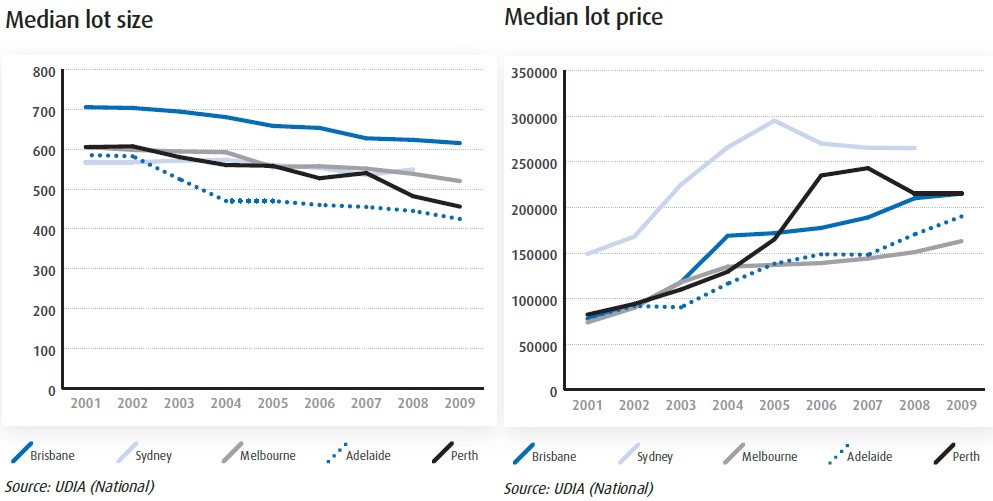
Second, the escalation of land values has not been restricted to the fringe only, with residential land values across Australia increasing rapidly relative to the broader economy:
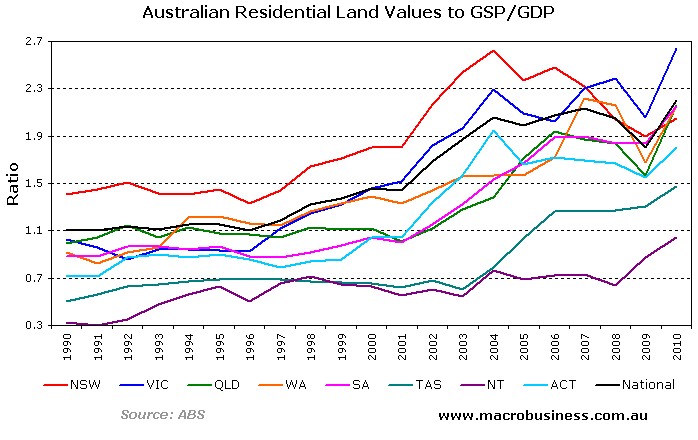
Third, Australia’s mortgage debt is now amongst the highest in the world, due in part to escalating land/house prices, which has required Australians to borrow big for housing [of course there is an element of chicken-and-egg between house prices and debt]:
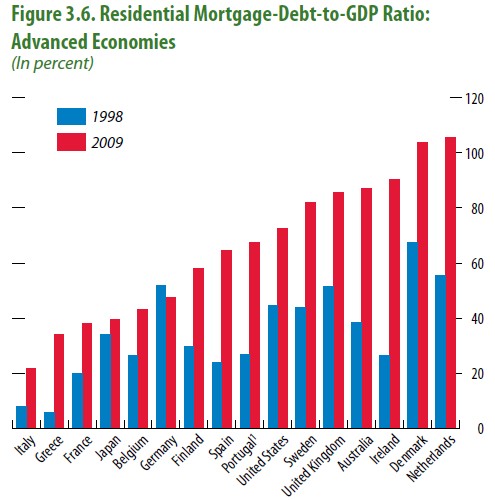
As I have argued previously, the causes of Australia’s unaffordable housing market are predominantly structural, brought about by urban consolidation policies, including: urban growth boundaries (UGBs) erected around Australia’s cities; minimum targets for ‘brownfield’ development (‘urban infill’); up-front infrastructure charges; and increasingly slow development approval processes.
With the effective supply of land reduced under these measures, developers were incentivised to compete vigorously for the available land within the UGBs. Meanwhile, lucky pre-existing land owners were effectively granted ‘quasi-monopoly rights’: with competition and contestability within the land market reduced, they could now demand higher prices. And because the price of pre-existing housing is set, to some extent, by the cost of new housing (which now comprised significantly higher land costs), these policies contributed to the rapid land/house price inflation experienced over the past decade across Australia’s cities.
It’s not as if Australia is lacking suitable land for housing; it has just been closed to development by UGBs and other planning restrictions, and/or a lack of funding for infrastructure.
Further, whilst easier access to credit can exacerbate a housing bubble – or any bubble for that matter – something must set up the expectations of capital gain, and the systematic discounting of downside risk, which is at the centre of a bubble. And having planning policies that continually retard the ability of supply to respond quickly to demand, thereby creating a sustained pattern of rising prices, generates those expectations and discounting of risk.
Such restrictive planning policies can also generate rising housing-related revenues and political donations from developers who have to ‘buy’ access to the political system to get their needed approvals and who can then ‘game’ the system.
From where I am sitting, the Texan model of urban planning seems far superior to the dysfunctional, prescriptive mess currently presiding across Australia. Having the opportunity to purchase a new family home for $150,000 would be a dream come true for many Australians, many of whom are instead required to load-up on debt to buy smaller homes at twice the cost.
The question you, the reader, needs to ask yourself is why aren’t Australia’s policy makers undertaking study tours to learn from their counterparts in Texas, instead of throwing endless sums of taxpayer dollars into demand-side measures – like the first home buyers grants and negative gearing tax concessions – which throw the demand-supply balance further out of kilter and makes homes even less affordable?

